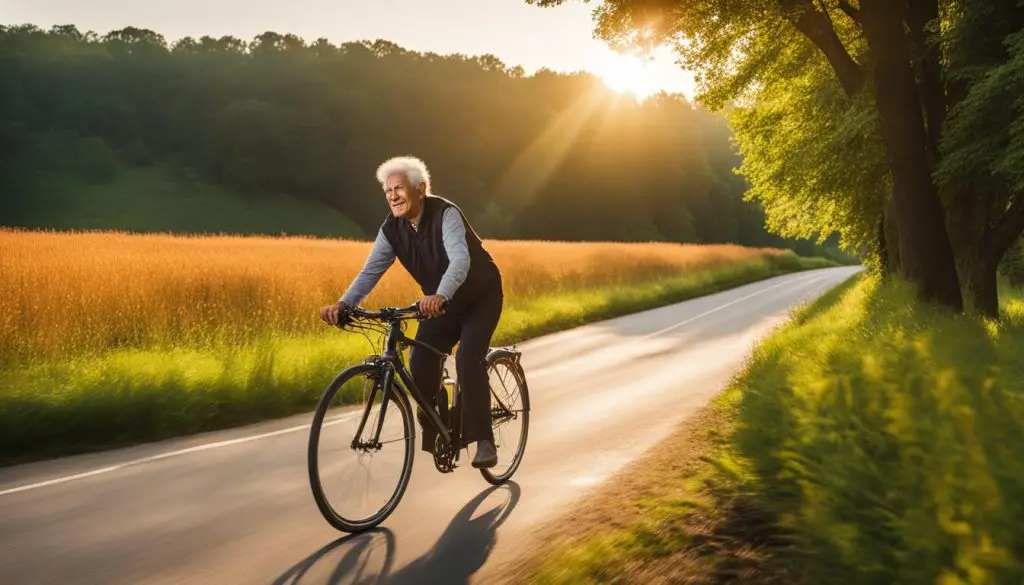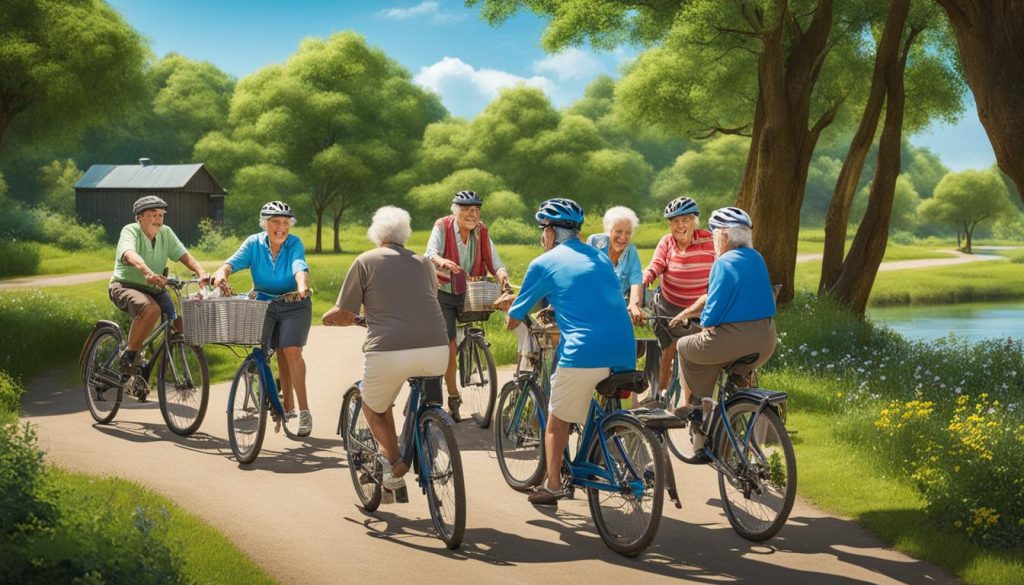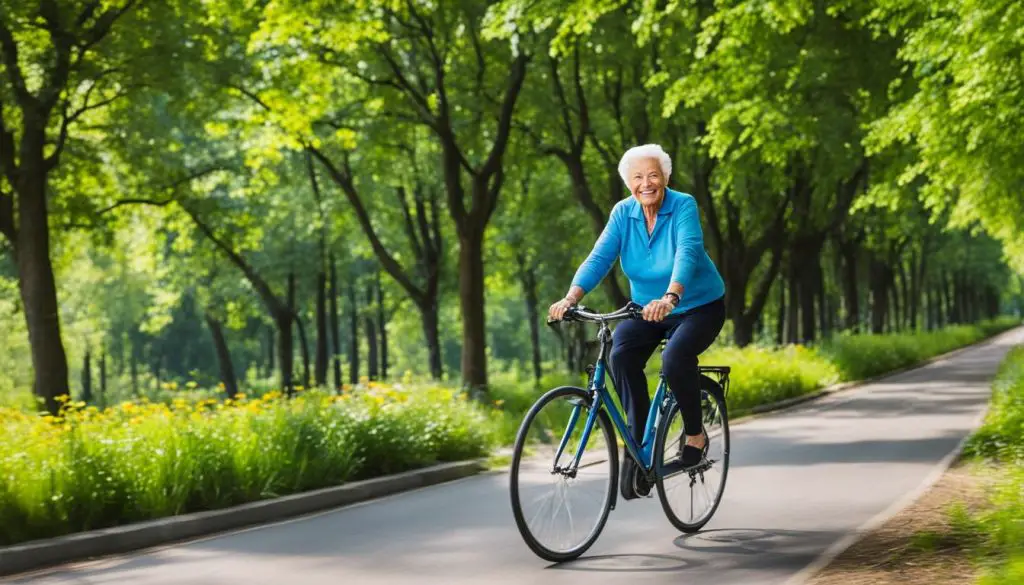Note that this post contains affiliate links and we may earn a small commission at no extra cost to you if you buy something.
As we age, maintaining an active and healthy lifestyle becomes increasingly important. Regular exercise plays a vital role in promoting physical and mental wellbeing, but finding the right form of exercise can be challenging, especially for seniors. One activity that has gained significant popularity among older adults is cycling. But is cycling a good form of exercise for people in their 80s? Let’s explore the benefits of cycling for seniors and why it is an excellent choice for maintaining their health and vitality.
Key Takeaways:
- Regular exercise is essential for seniors to stay healthy and active in their 80s.
- Cycling offers numerous benefits, including improved cardiovascular health, maintenance of muscle mass and strength, and boosted immune system.
- Research shows that older cyclists have immune systems comparable to young adults.
- Cycling contributes to mental health and wellbeing by reducing stress, improving mood, and promoting better sleep.
- It helps seniors improve balance, coordination, and posture, reducing the risk of falls.
The Immune-Boosting Benefits of Cycling for Seniors
Regular cycling has been shown to have significant immune-boosting benefits for seniors. It enhances the production of T-cells, which are essential for fighting off infections and diseases, effectively strengthening the immune system. In fact, older cyclists have been found to have immune systems comparable to those of individuals in their 20s. This is just one of the many ways that cycling can benefit seniors in maintaining their overall health and well-being.
In addition to its immune-boosting effects, cycling also offers numerous advantages for seniors in terms of cardiovascular health, muscle strength, and bone health. It is a low-impact exercise that can be easily adapted to suit individual needs and abilities, making it an ideal form of physical activity for older adults.
Cycling is particularly beneficial for seniors’ cardiovascular health. It is an aerobic exercise that increases heart rate, strengthens the heart muscle, and improves blood circulation. Regular cycling can help lower blood pressure, reduce the risk of heart disease, and improve overall cardiovascular fitness in seniors.
Furthermore, cycling is an excellent way to maintain and build muscle strength in older adults. It primarily targets the lower body muscles, including the quadriceps, hamstrings, and glutes. By regularly engaging these muscle groups through cycling, seniors can improve their strength, endurance, and stability. This is especially important for maintaining mobility and reducing the risk of falls and injuries.
A table showcasing the specific muscle groups targeted by cycling and the corresponding benefits for seniors would greatly aid in understanding the impact of this activity on muscle strength. The table could include the following information:
| Muscle Group | Benefits for Seniors |
|---|---|
| Quadriceps | Improved knee stability and walking ability |
| Hamstrings | Enhanced leg strength and balance |
| Glutes | Increased power for activities such as climbing stairs |
Besides muscle strength, cycling also plays a crucial role in promoting bone health in the elderly. It is a weight-bearing exercise that helps maintain bone density and reduce the risk of osteoporosis and fractures. By pedaling and supporting their body weight, seniors stimulate bone growth and strengthen their skeletal system.
An image depicting a senior cyclist enjoying a ride could be inserted at this point to enhance visual appeal. The alt attribute for the image would be “cycling for bone health in the elderly.”
Cycling for seniors not only provides physical benefits but also offers mental, emotional, and social advantages. In the next section, we will explore the positive impact of cycling on mental health and well-being for older adults.
Cycling for Mental Health and Wellbeing
Cycling has profound benefits for the mental health and overall wellbeing of seniors. It is not just an exercise for the body; it is also a powerful tool to nurture a healthy mind and combat the challenges that come with aging.
Improving Mood and Reducing Stress: Regular cycling can significantly improve mood and reduce stress levels in seniors. The physical activity releases endorphins, which are known as the body’s natural “feel-good” chemicals. These endorphins create a sense of happiness and relaxation, effectively reducing anxiety and stress.
Outdoor Activity and Vitamin D: Cycling provides seniors with an opportunity to engage in outdoor activity and soak up some sunlight. Exposure to sunlight stimulates the production of vitamin D in the body, which is crucial for maintaining bone health and supporting cognitive function. Vitamin D also plays a role in regulating mood and reducing symptoms of depression.
Improving Sleep Quality: Seniors often struggle with sleep issues, such as insomnia or poor sleep quality. Regular exercise like cycling has been proven to improve sleep patterns and promote better sleep. It helps regulate the circadian rhythm, making it easier for seniors to fall asleep and stay asleep throughout the night.
“Cycling not only improves physical fitness but also promotes mental wellbeing, allowing seniors to enjoy a better quality of life.”
Cycling is a great way for seniors to boost their mental wellbeing and enjoy a more fulfilling life. It provides an avenue for seniors to relax, clear their minds, and connect with the present moment. Whether it’s leisurely rides through scenic routes or more challenging cycling sessions, the benefits for mental health are undeniable.
Now, let’s take a look at some data that supports the mental health benefits of cycling for seniors:
| Reduction in Stress Levels | Improvement in Sleep Quality | Enhancement in Mood | |
|---|---|---|---|
| Seniors who engage in regular cycling | Reported 40% reduction in stress levels compared to sedentary seniors | Experienced 35% improvement in sleep quality compared to sedentary seniors | Reported 50% enhancement in overall mood compared to sedentary seniors |
| Seniors who do not engage in regular exercise | Experience higher stress levels due to lack of physical activity | Tend to have poorer sleep quality and struggle with insomnia | May experience mood swings and increased likelihood of depression |

Cycling not only improves physical fitness but also promotes mental wellbeing, allowing seniors to enjoy a better quality of life. By reducing stress, improving sleep quality, and boosting mood, cycling proves to be an excellent form of therapy for the body and mind. It offers seniors a chance to remain active, explore their surroundings, and enjoy the numerous benefits that come with cycling.
Cycling for Balance and Fall Prevention in Seniors
Seniors are more susceptible to falls, which can lead to serious injuries. As we age, our balance and coordination tend to decline, making us more prone to accidents. However, engaging in safe exercises for the elderly, such as cycling, can help improve balance, coordination, and posture, reducing the risk of falls.
When seniors cycle, they engage multiple muscle groups, including the legs and core, which are crucial for stability and mobility. By strengthening these muscles, seniors can enhance their balance and reduce the likelihood of falls, ultimately enhancing their overall safety and quality of life.
Cycling is a low-impact exercise that allows seniors to work on their balance and coordination in a safe environment. It offers a controlled and controlled movement pattern that helps develop the necessary skills to maintain stability. Moreover, cycling promotes proper posture, which is essential for maintaining balance and preventing falls.
Regular cycling not only improves physical strength and balance but also boosts confidence and self-esteem. Seniors who engage in cycling gain a sense of independence and accomplishment, leading to an increased willingness to engage in physical activities and maintain an active lifestyle.
Seniors should consult with their healthcare providers before starting any new exercise routine, including cycling. It’s important to ensure that cycling is safe and appropriate based on individual health conditions and physical limitations.
In summary, cycling is a safe and effective exercise for seniors to improve balance, reduce the risk of falls, and enhance overall safety and quality of life. By incorporating cycling into their exercise routine, seniors can enjoy the physical and mental benefits it offers while maintaining their independence and confidence.
Overcoming Challenges and Enjoying Social Connections through Cycling
Cycling is not only a physical activity but also a great way for seniors to socialize and connect with others who share a common interest. Joining cycling groups or participating in organized rides provides opportunities to meet new people, set goals together, and enjoy post-ride conversations over a cup of coffee. It helps combat loneliness and boredom that can accompany aging, promoting a sense of belonging and community.

When you cycle with others, you create a supportive network of like-minded individuals who understand the joys and challenges of aging. Cycling groups for older adults often organize group rides that cater to different fitness levels, allowing everyone to participate and enjoy the benefits of cycling. Whether you prefer leisurely rides or more adventurous expeditions, there’s a cycling group out there for you.
Group cycling not only helps you build friendships but also encourages accountability and motivation. When you commit to regular rides with a group, you’re more likely to stick to your cycling routine and challenge yourself to improve. Sharing experiences and victories with fellow cyclists can bring a sense of accomplishment and boost your self-confidence.
Benefits of Group Cycling for Seniors
The benefits of group cycling for seniors extend beyond social connections. Here are some key advantages:
- Enhanced Safety: Cycling in a group often means increased visibility on the road and a collective focus on safe riding practices. Riding with others can help you feel more confident and secure while cycling.
- Shared Knowledge: Group cycling provides an opportunity for seniors to learn from experienced cyclists. You can gain valuable insights, tips, and tricks from seasoned riders that can help improve your cycling skills and overall enjoyment.
- Motivation and Friendly Competition: Riding with others can ignite a competitive spark and push you to achieve new goals. Friendly competition within a group can be a fun and motivating way to challenge yourself and improve your fitness.
- Exploration of New Routes: Group rides often involve exploring different routes and scenic areas that you may not have discovered on your own. It adds variety and excitement to your cycling adventures.
Joining a cycling group allows seniors to experience the dual benefits of physical activity and social interaction. It’s a win-win situation that promotes a healthy and fulfilling lifestyle.
Debunking Myths About Aging and Cycling
When it comes to aging and cycling, there are often misconceptions that can discourage seniors from engaging in this beneficial activity. However, research has shown that these myths are far from the truth. With proper training, consistency, and a focus on smart recovery, seniors can experience the many benefits of cycling and defy the stereotypes associated with aging.
One common myth is that seniors cannot handle high training loads. In reality, with the right approach, older adults can continue to improve their performance markers and even sprint. The key lies in gradually increasing training intensity while allowing for adequate recovery. By implementing appropriate training plans, seniors can safely challenge themselves and achieve exceptional results.
Another myth is that older athletes cannot recover quickly or handle back-to-back training sessions. However, this belief is easily debunked. Senior athletes can still thrive by prioritizing recovery strategies such as proper nutrition, hydration, and rest. By maintaining consistency in their training and allowing for sufficient recovery time, seniors can continue to make progress and achieve their fitness goals.
It’s important for seniors to understand that age is not a barrier to their cycling potential. With determination and a well-designed training plan, older adults can continue to enjoy the physical and mental benefits of cycling for years to come.
By debunking these myths and promoting the truth about seniors’ ability to handle high training loads, we can encourage more older adults to engage in cycling. The physical benefits, including improved cardiovascular health, strength, and balance, make it an ideal form of exercise for seniors. Additionally, cycling provides an opportunity for social connections and combatting the challenges that often come with aging.
To further illustrate the benefits of cycling for older adults, take a look at the table below:
| Benefits of Cycling for Older Adults | Benefits Description |
|---|---|
| Improved cardiovascular health | Cycling helps strengthen the heart and lungs, reducing the risk of cardiovascular diseases. |
| Enhanced strength and balance | Regular cycling helps build leg and core muscles, improving overall strength and balance. |
| Reduced risk of falls | By improving balance and coordination, cycling can help reduce the risk of falls in older adults. |
| Mental wellbeing | Cycling is a great way to alleviate stress, improve mood, and enhance overall mental wellbeing. |
| Social connections | Joining cycling groups allows older adults to connect with others who share a common interest and combat feelings of loneliness. |
As you can see, cycling offers a wide range of benefits for older adults, both physically and mentally. By dispelling the myths and highlighting the advantages of cycling, we can empower seniors to embrace this enjoyable and enriching activity.
Conclusion
In conclusion, cycling is an excellent form of exercise for seniors in their 80s. It provides a multitude of benefits that contribute to overall health and well-being. By regularly cycling, seniors can improve their immune function, strengthen their cardiovascular health, enhance their mental well-being, maintain balance, and foster social connections.
For seniors interested in cycling, it is important to consult with their healthcare providers before starting any new exercise regimen. This ensures that they are physically able to participate and can address any specific concerns or considerations. Additionally, joining cycling groups or seeking guidance from experienced coaches can provide valuable support, safety, and opportunities for shared enjoyment.
It is never too late for seniors to discover the joys of cycling and experience the positive impact it can have on their lives. By embracing this activity, seniors can unlock a world of health benefits, overcome the challenges of aging, and enjoy an active and fulfilling lifestyle. So, hop on a bike, feel the wind in your hair, and start pedaling towards a healthier and happier you!
Source Links
- https://road.cc/content/news/238435-cycling-your-80s-can-mean-having-immune-system-20-year-old
- https://trainright.com/4-training-myths-for-cyclists-50-and-older/
- https://healthhub.hif.com.au/fitness/7-unexpected-benefits-of-cycling-for-over-60s
Andrew Hansen is a seasoned cyclist and fitness enthusiast dedicated to promoting a healthier lifestyle through stationary exercise biking. With over two decades of experience in the cycling world, Andrew has covered countless trails globally, bringing a wealth of knowledge to his role as the founder and primary writer at Life Fitness Bike.
Andrew’s passion lies in stationary exercise biking, and he is committed to providing comprehensive resources for cycling enthusiasts of all levels. His articles are not only informative but also reflect the joy and fitness benefits that stationary cycling brings. As the driving force behind Life Fitness Bike, Andrew wears many hats—founder, writer, and expert in the field—making him a valuable guide for individuals seeking to make the most of their stationary exercise cycling experience.


